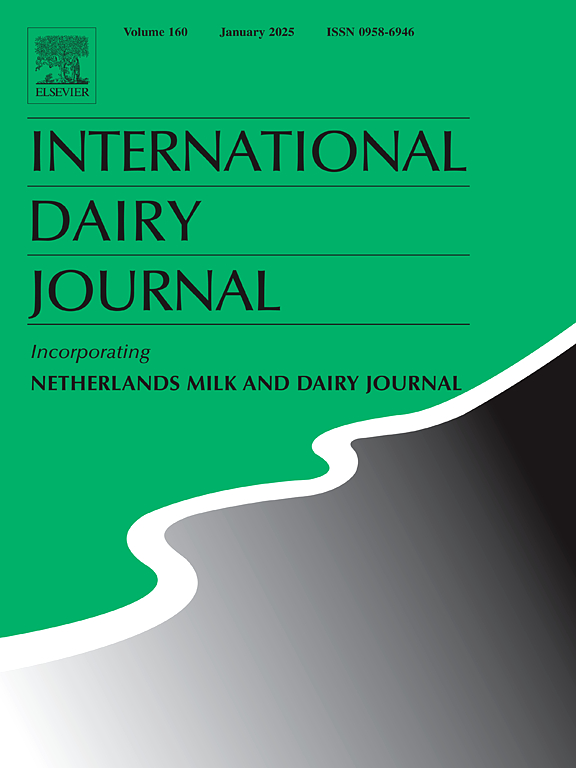牛日粮和泌乳期对黄油和切达干酪中维生素 K 含量的影响
IF 3.1
3区 农林科学
Q2 FOOD SCIENCE & TECHNOLOGY
引用次数: 0
摘要
本研究调查了在泌乳早期、中期和晚期喂养三种不同日粮(牧草饲喂日粮(GRS)、全混合日粮(TMR)和部分混合日粮(PMR))的奶牛生产的黄油和切达干酪中维生素 K 的含量。采用高效液相色谱法(HPLC)和荧光检测器对维生素 K1 和甲萘醌 (MK)-4、7 和 9 进行了定量检测。结果表明,用较高比例的牧场饲养牛奶制成的黄油和切达奶酪的 K1 含量明显更高(P < 0.05)。GRS黄油的MK-4含量最高(P <0.05),而TMR切达奶酪的MK-4含量最高(P <0.05),其次是GRS和PMR奶酪。与早期或晚期泌乳阶段相比,中期泌乳黄油含有更高浓度的 K1 和 MK-4(P < 0.05)。晚乳期切达奶酪中的 K1、MK-4 和 MK-9 含量明显高于早期或中期奶酪(P < 0.05)。这些研究结果表明,牧草喂养比例较高的牛日粮可以提高乳制品中的维生素 K 含量。本文章由计算机程序翻译,如有差异,请以英文原文为准。
The effect of bovine diets and stages of lactation on vitamin K content in butter and Cheddar cheese
This study investigated the vitamin K content in butter and Cheddar cheese produced from the milk of cows fed three different diets: pasture-fed (GRS), total mixed ration (TMR), and partial mixed ration (PMR), across early, mid, and late stages of lactation. Vitamin K1 and menaquinones (MK)-4, 7, and 9 were quantified using high-performance liquid chromatography (HPLC) with a fluorescence detector. Results showed that butter and Cheddar cheese made from higher ratio of pasture-fed milk exhibited significantly higher K1 levels (P < 0.05). GRS butter demonstrated the highest MK-4 content (P < 0.05), whereas TMR Cheddar cheese showed the highest MK-4 levels (P < 0.05), followed by GRS and PMR cheeses. Mid-lactation butter contained higher concentrations of K1 and MK-4 compared to early- or late-lactation stages (P < 0.05). Late-lactation Cheddar cheese contained significantly higher K1, MK-4, and MK-9 than early or mid-lactation cheeses (P < 0.05). These findings suggest that bovine diets with a higher pasture-fed ratio can enhance the vitamin K content in dairy products.
求助全文
通过发布文献求助,成功后即可免费获取论文全文。
去求助
来源期刊

International Dairy Journal
工程技术-食品科技
CiteScore
6.50
自引率
9.70%
发文量
200
审稿时长
49 days
期刊介绍:
The International Dairy Journal publishes significant advancements in dairy science and technology in the form of research articles and critical reviews that are of relevance to the broader international dairy community. Within this scope, research on the science and technology of milk and dairy products and the nutritional and health aspects of dairy foods are included; the journal pays particular attention to applied research and its interface with the dairy industry.
The journal''s coverage includes the following, where directly applicable to dairy science and technology:
• Chemistry and physico-chemical properties of milk constituents
• Microbiology, food safety, enzymology, biotechnology
• Processing and engineering
• Emulsion science, food structure, and texture
• Raw material quality and effect on relevant products
• Flavour and off-flavour development
• Technological functionality and applications of dairy ingredients
• Sensory and consumer sciences
• Nutrition and substantiation of human health implications of milk components or dairy products
International Dairy Journal does not publish papers related to milk production, animal health and other aspects of on-farm milk production unless there is a clear relationship to dairy technology, human health or final product quality.
 求助内容:
求助内容: 应助结果提醒方式:
应助结果提醒方式:


